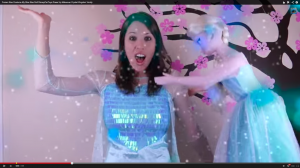
The Cookie Monster stares blindly ahead as he tries to eat Lightning McQueen, Mater and a few other characters from “Cars.” This is the plot of a minute-long video made by the YouTube channel DisneyCarToys. The channel, which was started in 2012, has almost 1 million subscribers, and the Cookie Monster video alone has nearly 20 million views.
Another video by the same channel, titled “Frozen Elsa Kids Ride Barbie Kelly Amusement Park Kiddie Coaster Ride in Alex’s Dream,” features several Disney princesses and a toy amusement park and has attracted nearly 300,000 views.
The channel’s success reflects the growing popularity of videos centered on toys. Socialblade.com, a media analytics website, lists three such channels among the 10 fastest-growing on YouTube. DisneyCollectorBR, another toy channel, is at the top of the list.
For adults, the videos may seem boring, unusual or even annoying. For children, the videos can be fun and entertaining. The videos generally have, if anything, a unique plot and feature popular characters from movies such as “Frozen” and “Cars.” The characters even have voices played by both adults and children.
“I think that kids are very geared into toys, and that’s what they want,” said Sarah Coyne, an associate professor in the School of Family Life at BYU. “So it’s cool for them to watch people play with them.”
The popularity of these types of videos reflect recent studies that have found that media use can effectively replace actual social behavior. The displacement hypothesis is the tendency for new media to substitute for, or displace, real-world activities. It is possible that the children can replace time playing with actual toys by watching videos of others play with them. While children can be equally entertained by the videos, some parents could not imagine replacing the time they spent playing with their children.
“I remember playing with trains with my son, and we had so much fun setting up those trains,” said Michelle Lehnardt, who was named Utah’s Young Mother of the Year in 2013. “It just seems rather sad to be watching someone else play, rather than to play yourself.”
Lehnardt is not completely against media use. She said while using media can be a helpful parenting tool, it should not replace parenting and actual play time with children.
“I can see if a parent used it to get inspiration to find something fun to do with their kids,” she said. “But I think it would be bad to use it on a regular basis.”
Coyne also believes that the videos should not replace spending time with family. She said even though the videos can be entertaining, it is hard for her to see many positive outcomes from watching others play.
Coyne instead recommends a different variety of media for children, which have led to benefits when used correctly.
“There’s so many other, good media out there for kids to watch,” she said, “shows that show good pro-social behavior and empathy and good moral understanding.”
One show Coyne highly recommended was “Sesame Street,” which has had dozens of studies done on it. The studies found that watching the show is associated with “increased language development, better academic achievement and imaginative play.” Other shows she considered positive media include “Super Why,” “Octonauts” and “Sofia the First.”




